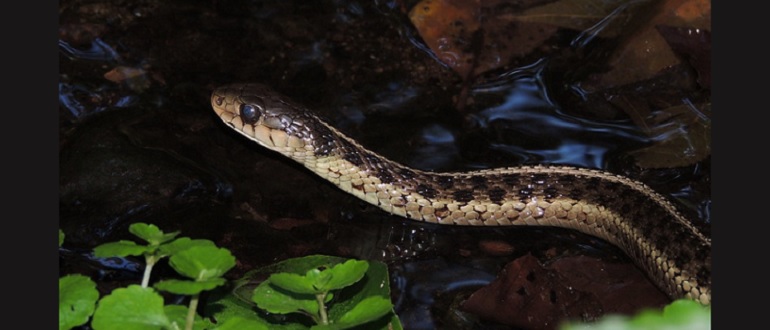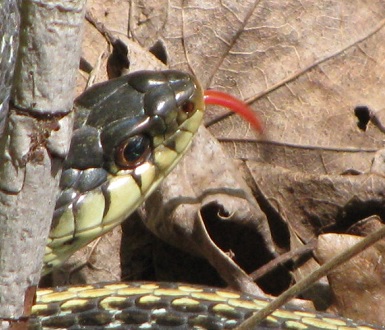GET TO KNOW
Eastern garter snake
Garter snakes are our shy, and mostly hidden, neighbors. Harmless and non-aggressive, they are adaptable to a wide variety of habitats and are known to happily share suburban yards and gardens. As the most common type of snake in Michigan, eastern garters are sometimes found tucked away in a wood pile, hiding in the brush, or even sunbathing on a warm stone.
FUN FACT: The small town of Narcisse in Manitoba, Canada is known for the largest winter dens of garter snakes. It is estimated that individual snakes travel as far as 20 miles to join these communal dens. According to the Canadian government, there are 4 active dens along a 3 km observation trail where tens of thousands of garters gather to survive winter in the crevices of a large limestone deposit. It is the largest known gathering of snakes in the world, and it draws a large gathering of curious tourists. Each spring, the curious watch as 50,000 (or many more?) red-sided garter snakes engage in a mass mating ritual. These snakes writhe and coil in giant tangles – known as mating balls – that contain dozens of snakes per coil. It is a bit hard to even imagine. For a short video, please click Snakes at Narcisse
But please remember, garter snakes have no wish to interact with humans. Given the opportunity, they will slither away to avoid contact.
Eastern garter snakes do not have front fangs to inject a poisonous venom. They have back teeth and heavy gums and chew on prey as they swallow. Their saliva contains a mild neurotoxin designed to incapacitate small amphibians and rodents. Most humans incur no significant reaction to garter snake saliva. (Unfortunately, as with bees, a few individuals may have an allergic reaction.) As always, it is best to avoid being bitten by treating garter snakes with basic common sense. Do not provoke or touch them. Simply appreciate their presence from a respectful distance.
Garters are medium sized snakes (generally about 2 ft – 4 ft long) with a variety of subspecies and color patterns. Our local subspecies, the eastern garters may be brown, green, or even black. They are best identified by a prominent light-colored stripe (white or yellow) down the center of their back, a checkerboard pattern of dark/light colors along their sides, and light bellies. Eastern garters also have a unique red & black tongue. Males and females have the same coloring, but females are generally somewhat larger.
HABITAT AND LIFE CYCLE
Although eastern garter snakes have adapted to live in almost all habitats (including suburbia), they actually prefer wetlands. Accomplished at both swimming and climbing, they will easily dip into a stream or climb a tree to secure a meal or avoid a predator. Garters occupy a place midway in the food chain where they feed on any smaller creature they can catch. In turn, they are heavily preyed upon by hawks, crows, raccoons, foxes, skunks, bullfrogs, and larger snakes. Like many creatures, the species depends on high birth rates for overall survival.
Snakes, in general, have a very strong sense of smell. Garters find both prey, and other garters, by smell. And while they breath in oxygen through their nostrils, they collect scents (molecules of chemicals in the air) on their tongue. The scent molecules are then transferred, by the tongue, to a special organ (called the Jacobson’s organ) in the soft tissues above the mouth. The Jacobson’s organ carries the receptors that sense and identify chemical markers.
Since snakes are ectotherms (a.k.a. cold-blooded), they cannot generate body heat by burning food calories and cannot regulate body temperature internally. Thus, our garter snake friends move about – cool shade / warm sun – as needed to regulate body temperature. However, there is a trade-off. Cold-blooded creatures need relatively little food, whereas warm-blooded creatures (endotherms) require large (and regular) infusions of calories to maintain body temperature. And while the cold-blooded spend much of their time resting in appropriate microenvironments (warm or cool) the “warm-blooded” must spend the majority of their time in an endless (often desperate) search for food.
Garter snakes are quite cold tolerant for snakes and are active for a longer period of the year than most other snake species. In order to survive winter, garters seek communal dens (in rock crevices, under logs, or in the abandoned dens of other animals) where they gather to conserve body heat. They enter a type of winter rest known as brumation for cold-blooded creatures with a reduced metabolism and an inactive state of wakefulness. On the occasional warm day, they may even emerge for a bit of sunbathing.
Once spring arrives, garters emerge from their dens and engage in literal mating frenzies. Females give off pheromones that attract males, and a great many males coil around a single female in a tight “mating ball.” However, once mating is complete, the female takes off to establish a summer territory to incubate her eggs. Unlike most snakes, female garters retain both eggs and sperm inside the body and incubate eggs internally for two to three months. By carrying her eggs inside her body, the mother garter protects them from predators and keeps them securely warm. In late summer, she gives birth to live baby snakes in a litter that may range from just a few to as many as 70 or 80 tiny snakes. Newborn garter snakes are only 5 to 8 inches long, but they are completely self-sufficient and independent from the moment of birth.
TAKE ACTION
Although eastern garter snakes prefer wetland areas, they are sometimes found around suburban homes and gardens. They are shy and harmless neighbors. There is no need to be afraid of – or kill – these snakes. If a garter snake is encountered, the best practice is to simply stop and wait for it to slither on its way. Garter snakes are not aggressive and not venomous. However, please do not pick them up, for they are likely to bite in self-defense.
If you wish to discourage garter snakes from sharing in your yard, the best practice is to remove any likely hiding places such as piled up rocks, logs, debris, and areas of overgrowth. However, please help FOTR maintain healthy, natural wooded and wetland areas throughout our watershed, so our slithery friends may also find a home. You can help by spreading a good word for garter snakes and other watershed creatures. Watch our Facebook page for ways to volunteer.
MAIN PHOTO CREDIT: Eastern garter snake (Thamnophis sirtalis sirtalis) – Anita Gould CC-BY-NC-2.0- image cropped

